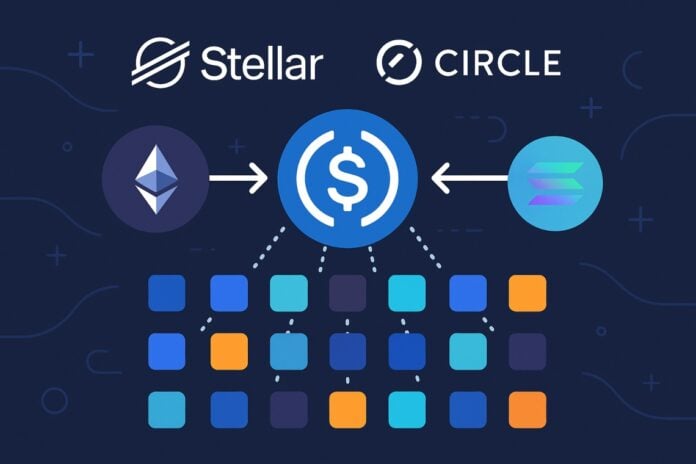Circle has extended the Cross‑Chain Transfer Protocol (CCTP) on Stellar, enabling native and direct transfers of USDC across more than 15 blockchains, including Ethereum, Solana, and Base (CryptoNews).
In this context, the burn‑and‑mint 1:1 mechanism eliminates the need for external bridges, ensuring faster settlements and verifiable compliance rules throughout the entire transfer process.
For technical details and a list of supported chains, refer to Circle’s official documentation: Circle – Multi‑chain USDC on Stellar.
According to data collected from public on-chain monitoring and integration reports updated in 2025, the average latencies observed on fast-finality networks consistently result in being under 60 seconds.
Industry analysts also note that the elimination of wrapped tokens simplifies reconciliation and audit, measurably reducing operational complexities for exchanges and wallets.
Summary
In Brief
- USDC transferable between Stellar and over 15 blockchains (e.g., Ethereum, Solana, Base) for native cross-chain movements.
- Mechanism of burn at the source / mint at the destination without wrapped token (Circle Developers).
- Typical times: from seconds to a few minutes, depending on the purpose of the chain (CryptoNews).
- Benefits for DEX/CEX, wallets, and dApps; fiat access thanks to the MoneyGram network with over 475,000 physical locations (Circle).
What changes with the integration on Stellar
With CCTP V2, USDC is transferred natively between Stellar and other networks, without resorting to the creation of “wrapped” assets.
The transfer operation occurs through the burning of USDC on the origin chain and the subsequent minting of the equivalent on the destination, maintaining the 1:1 parity. In fact, this process significantly reduces the counterparty risks typical of custodial bridges and simplifies liquidity management between ecosystems.
The updated list of supported blockchains is available in Circle’s official documentation and provides an accurate overview of effective interoperability.
How it works: burn/mint and attestations
The protocol sends a burn request on the source chain and, after adequate attestation (CryptoNews), proceeds with the mint on the destination chain. The operation is orchestrated through Circle’s attestation services and specific smart contracts, which validate the event and authorize the minting.
That said, the timings are indicative: for fast-finality blockchains, like Solana or Stellar, the transfer occurs in about 4–60 seconds, while on probabilistic finality networks, like Ethereum, it may take a few minutes depending on congestion (during peak periods on Ethereum, the window can extend beyond 10 minutes). The result is a verifiable end-to-end flow that maintains supply parity.
Impact on Markets and Traders
For DEX, the cross-chain flow of USDC promises to improve prices and the depth of the book, while CEX can consolidate liquidity instead of fragmenting it into isolated pools.
Wallets and DeFi protocols benefit from more efficient access to USDC across multiple networks, also supported by fiat on/off-ramps thanks to the MoneyGram network (Circle).
For institutional operators, the elimination of wrapped tokens facilitates reporting, reconciliation, and audits, reducing operational complexities and the risk of mismatching between assets. In this context, the uniformity of the transfer model also positively impacts risk management.
Programmable Transfers for dApps
CCTP V2 allows attaching metadata to transfers, triggering automatic actions on the destination chain (such as credits, fund unlocking, or internal routing).
On Stellar, this integration facilitates the implementation of multi‑chain logic without the need for complex liquidity routers, offering developers more modular pipelines and programmable transfers with predictable paths and greater event traceability. Yet, the ease of use does not compromise the necessary controls during the attestation phase.
Limitations and Risks to Consider
- Centralization of attestation: the attestation service is managed by Circle; its availability and policy can affect the continuity of the flow.
- Chain finality: confirmation times vary; on slow finality networks, transfers might take several minutes.
- Costs: the fees, both on the source chain and on the destination chain (gas or commissions), vary depending on the traffic and network congestion, with L1 potentially being more expensive.
- Compliance: USDC has blacklist and freeze functions in regulatory cases, therefore it is important to evaluate the applicable policies and jurisdictions.
- Infrastructure dependencies: potential downtimes of RPC, oracles, or other related services can introduce temporary disruptions.
- Partial coverage: not all blockchains or assets are supported; it is necessary to check the limits and versions of the SDK.
Key Numbers
- Interoperable networks: 15+ (refer to the updated Circle documentation).
- Model: burn/mint 1:1 with attestation.
- Execution time: from seconds to a few minutes depending on the blockchain; on Stellar/Solana typically 4–60 seconds, on Ethereum in congestion conditions up to >10 minutes.
- Off-ramp network: MoneyGram with over 475,000 physical locations (Circle).
Quick FAQ
Can Stellar Become a Multi-Chain Liquidity Hub?
Yes, the integration of CCTP V2 allows USDC to be transferred natively between Stellar and other networks, facilitating global payments, treasury management, and cross‑chain lending. The final impact will depend on the adoption by DEX, CEX, and dApp on each blockchain. Ultimately, what matters is the real connectivity put into production by the operators.
Are wrapped tokens involved?
No. The transfer is based on the process of burn of USDC at the source and the subsequent mint at the destination, thus maintaining the overall supply balance.
What are the typical costs?
The costs vary depending on the fees applied on the source and destination blockchains and the network congestion. On L2 or high-efficiency networks, the costs are generally contained, while on L1 during periods of high congestion, they can be higher. For more details, it is advisable to consult the updated documentation from Circle.
Related Insights
- All articles on USDC
- Latest news on Stellar
- Practical Guide to CCTP V2
Editorial Note: The exact date of the announcement and the complete list of the “15+ chains” will be updated as soon as Circle releases further details in their official communications.




